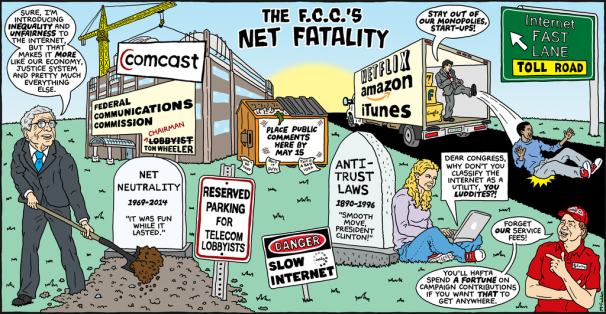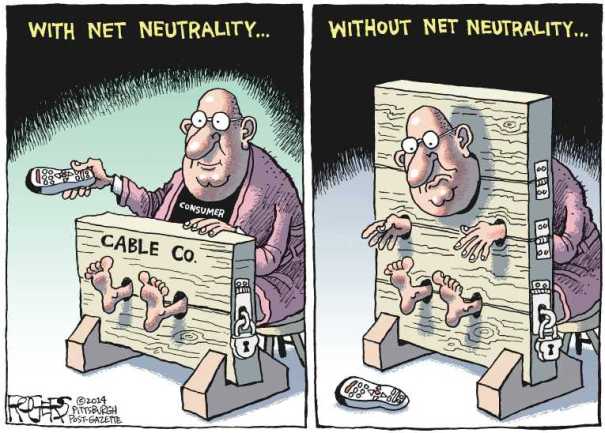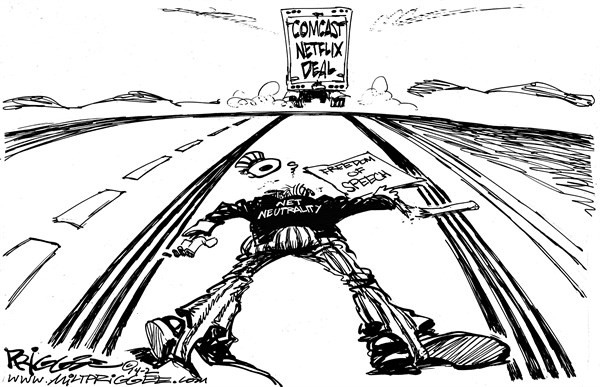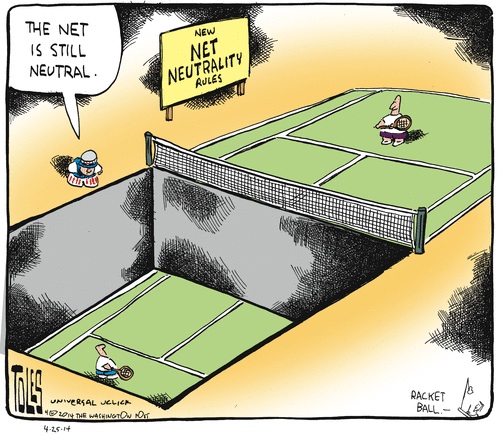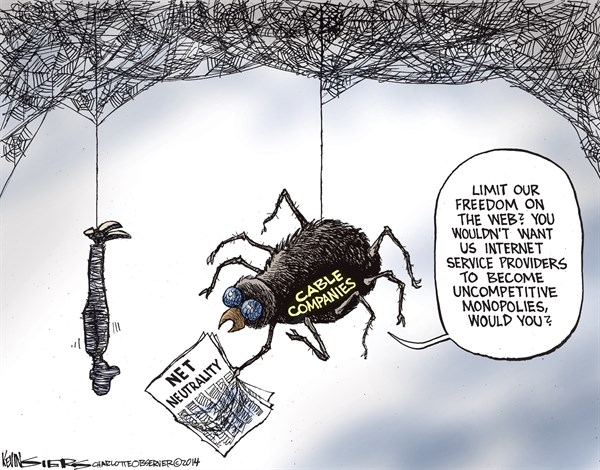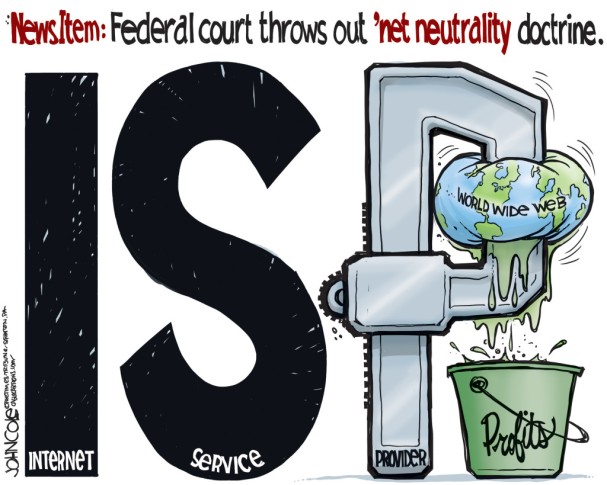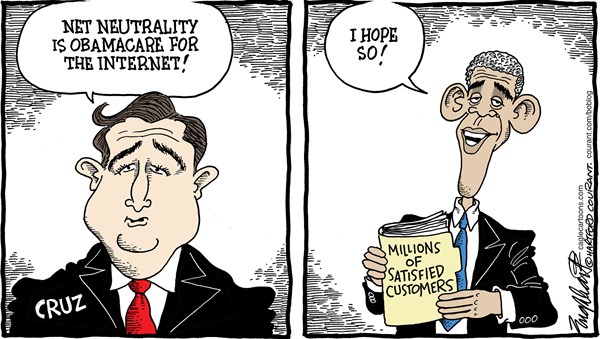Link can be found here
Team Member Name: Dylan Harlow
Publication: The Daily Kos
Date: 4/30/14
Cartoonist: Brian McFadden – US
U.S./International
Title of Cartoon: The F.C.C.’s Net Fatality
Cartoon #7
What action is taking place in the cartoon? What is the context?
A lot of different things are happening in this cartoon, and it seems that the artist intended to juxtapose many of the various components of the issue by framing them all in the same scene. On the left half of the cartoon, FCC Chairman Tom Wheeler is seemingly burying Net Neutrality in the ground. A speech bubble is attached to him that uses sarcasm to highlight how the chairman is attempting to make the Internet more like the Economy, the justice system and other elements of society, all of which are highlighted negatively. Above Wheeler is the FCC building with a crane lowering a Comcast sign in front of the Federal Communications Commission’s sign. Next to the building is a dumpster that reads “Place public comments here by may 15” implying that the FCC is ignoring public opinion while trying to give off the appearance of taking it into consideration. Moving to the right side of the cartoon, we see a slight shift in tone. Towards the top, you see a truck with many various technology corporations riding off into the sunset, while a white businessman representing large corporations kicks off a black man representing startup companies. This takes place on a “toll road” called “Internet Fast Lane” which highlights one of the major issues of Net Neutrality. Below is an average consumer and a cable company representative. The consumer voices concerns about why congress is not taking more progressive action towards clamping down on Net neutrality rules. The cable company representative portrays arrogance; he explains that the company will make even more money now that net neutrality has been buried. This cartoon came months after the D.C Circuit court turned down Open Internet Rules made by the FCC, but still came in the midst of an ever present debate about the future of the internet (Feld, 2014). Publication was seven days after the Wall Street Journal leaks the FCCs intent to rely on powers already granted to them in order to enforce Net Neutrality rules (Nagesh, 2014). This cartoon was obviously released at a time in relevant enough to bolster the side for Net Neutrality. Criticizing essentially everyone possible in the demise of Net Neutrality, this cartoon tries to garner as much attention as possible in order to shed light on the issue.
- Positive framing of the issue
- Framing is supportive to supporters of Net Neutrality
- Framing is opposed to opponents of Net Neutrality
Analysis/Reality: This cartoon seemed extremely complex at first glance. All of the points it makes are almost entirely based in sarcasm to the point where some of them are unclear. Upon deeper analysis, all of the points it is making are extremely left leaning and biased towards a pro Net Neutrality mentality. The drawing touches on everything from the FCC’s lack of action towards keeping Net Neutrality, all the way to Comcast’s powerful influence over the FCC through lobbying. The reality this cartoon is trying to frame is that the FCC is at the mercy of ISPs like Comcast. Since Comcast is seemingly in control of the FCC actions, the consumer is left unhappy, and monopolies are developed under the lack of Net Neutrality regulations. The cartoon depicts a much exaggerated view of reality in order to prove a point. A point that is seemingly uncontested when viewing this particular cartoon.
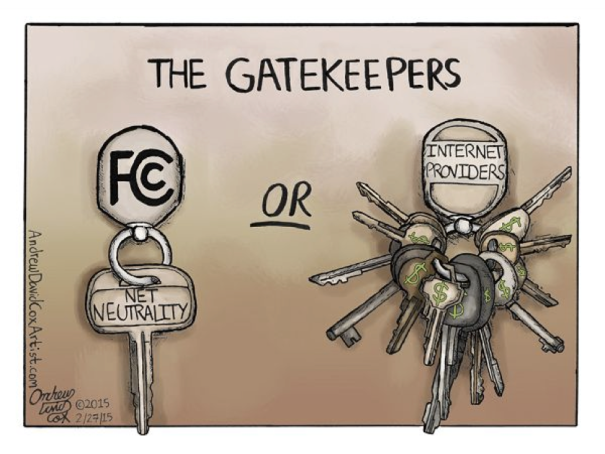
Link can be found here
Team Member Name: Samantha Kiser
Publication: The Association of American Editorial Cartoonist
Date: Friday, February 27, 2015
Cartoonist: Andrew David Cox
U.S./International
Title of cartoon: The Gatekeepers
Cartoon#1
What action is taking place in the cartoon? What is the context?
In this cartoon there are two key rings, one of the key chains is the logo for the Federal Communication Commissions, and the other keychain says Internet providers. Above the two sets of keys in bold letters says “THE GATEKEEPERS”, meaning that two stakeholders in Net Neutrality are the FCC and ISP’s like Comcast or Time Werner, they are considered the “gatekeepers” of the Internet. The ISP’s wanted to control what we access on the Internet by charging other companies that would in turn charge the public. The disappearance of Net Neutrality would also allow ISP’s have the ability to block sites that they chose, and also choose what the public is able to access. They would have become the “gatekeepers” if the FCC had not voted for Title II Net Neutrality ruling under the Telecommunications act that went through on February 26. Had the Title II rule not passed the ISP’s would have become the “gatekeepers”. These rules were set up in order to keep the Internet free and open. This cartoon is showing that although we have Net Neutrality, there is still a gatekeeper. Before the Title II ruling there wasn’t a gatekeeper at all. This cartoon is saying the FCC will now become the “gatekeeper” of the Internet. The Title II Net Neutrality rules will basically regulate common Internet carriers to make sure they act in the Interest of the public. In order to have a free and open Internet, Net Neutrality was greatly supported by the public but they don’t necessarily agree that the FCC, or any thing, should control what the public can and cannot access on the Internet.
Tone of the cartoon:
- Positive framing of the issue
- Framing is supportive to supporters of Net Neutrality
- Framing is opposed to opponents of Net Neutrality
What “reality” is constructed/framed about your issue?
The reality that is being framed is that the FCC want a unified, free Internet, and Internet providers want cluttered Internet with a price. This cartoon is framing the FCC as the better, more practical solution. There is a symbolic meaning behind using keys in this cartoon. For example, a gatekeeper holds the keys to a gate that leads to a castle. They are the ones who determine who enters the property. In this cartoon is has the same idea. The group who holds the key or keys will be the gatekeeper. The cartoonist clearly expresses his opinion in this cartoon with the way he drew the two key chains. The Internet provider key chain is cluttered, looks dingy and dirty and less clean. The FCC key chain only has one large key, showing that it is more appealing to the eye. From this you can see that the cartoonist feels that Net Neutrality is the better deal. To have one free key to the Internet is better than having many, dirty and expensive keys. The cartoonist uses framing with value-laden words in order to express his opinion in this cartoon. By using the word “gatekeeper” he portrays a deeper meaning in the cartoon.
Link can be found here
Team Member Name: Nicole Cowdell
Publication: The Comic News
Date: November 14, 2014
Cartoonist: Rob Rogers
U.S./International
Title of Cartoon: Net Neutrality Rules Considered
Cartoon #:11
Tone of the cartoon:
- Positive framing of the issue
- Framing is supportive to supporters of Net Neutrality
- Framing is opposed to opponents of Net Neutrality
What action is taking place in the cartoon?
This cartoon shows two different ‘realities.’ The first one is a world with Net Neutrality. In this version the consumer is smiling, with easy access to his TV remote. However, his feet are still restrained by the labeled ‘Cable Companies.’ The second reality is a world without Net Neutrality. In this version the consumer is completely restrained with no access to his remote. He is under total control of the Cable Companies. This cartoon highlights the often unmentioned fact that even with Net Neutrality in place, consumers are still largely controlled by cable companies.
What “reality” is constructed/framed about your issue?
The cartoonist is opposed to a world without Net Neutrality, however his opinion clearly comes through; even a system with Net Neutrality in place isn’t perfect. The cable companies still possess more power than the cartoonist would like. His excellent use of labeling in this cartoon makes sure that viewers understand the restraints are being placed upon us, the consumers, by the nation’s large cable companies. Whether we have Net Neutrality or not, we are still at the mercy of big businesses, however, without Net Neutrality regulations in place, we would be far worse off.
What is the context?
This cartoon was published on the 14th of November and it was most likely a response to President Obama’s actions a few days earlier on the 10th. On that day President Barack Obama expressed support for Net Neutrality and endorsed Title II Authority. This basically means that he encouraged the FCC, or the Federal Communications Commission, to keep the internet free and open for everyone while establishing Title II Authority derived from the Telecommunications Act (A Timeline of…, 2015). While not strongly supporting Net Neutrality, this editorial cartoon does express strong discontent about not having it present in society.
Link can be found here
Team Member Name: Nicole Cowdell
Publication: The Cagle Post
Date: February 27, 2014
Cartoonist: Milt Priggee
U.S./International
Title of Cartoon: Net Neutrality
Cartoon #:12
Tone of the cartoon:
- Positive framing of the issue
- Framing is supportive to supporters of Net Neutrality
- Framing is opposed to opponents of Net Neutrality
What action is taking place in the cartoon?
This cartoon implements great use of both labeling and symbolism. The cartoon shows Uncle Sam, a symbolic figure in American culture, run over by a truck speeding away labeled the ‘Comcast Netflix Deal.’ Uncle Sam’s sign labeled ‘freedom of speech’ lays broken on the side of the road. Our right to free speech is something that the American people take pride in, conveying the loss of this right by showing it broken and run over shows that the cartoonist fears it could be taken away in a society without Net Neutrality.The use of Uncle Sam in this cartoon is also great because it is a symbol easily recognizable among the American people. Uncle Sam is often used to represent American society and seeing him run down by corporate businesses is disheartening to society. The use of these characteristics is a great way for the cartoonist to convey his views.
What ‘reality is constructed/framed about your issue?
The cartoonist believes that the American people’s freedom of speech is in jeopardy. With deals such as the Netflix and Comcast one, ISP’s are gaining more and more power, further restricting the free and open environment on the internet. The cartoonist believes that without Net Neutrality in place our society risks losing our voice and free speech.
What is the context?
This cartoon was clearly in response to the Comcast Netflix deal that is represented within the cartoon. This cartoon was published on Feb. 27, 2014. A few days prior Comcast and Netflix announced a new deal in which “Netflix will pay Comcast for faster and more reliable access to Comcast’s subscribers” (Wyatt & Cohen, 2014). This deal goes against the basic principles of Net Neutrality and is what the regulations were put in place to help avoid. The cartoonists anger against the Comcast Netflix is apparent in the cartoon and their argument is easily understood and conveyed to the public.
Link can be found here
Team Member Name: Kayla Swenson
Publication: The Washington Post
Date: April 25, 2014
Cartoonist: Tom Toles
U.S./International
Title of cartoon: Net Neutrality
Cartoon#13
Tone of the cartoon:
- Positive framing of the issue
- Framing is supportive to supporters of Net Neutrality
- Framing is opposed to opponents of Net Neutrality
What action is taking place in the cartoon? What is the context?
This cartoon shows two people playing tennis. On one side there is a man in blue shorts standing in a walled arena, with the net on top and out of reach. On the other side is a man with red shorts waiting for his opponent to serve. Uncle Sam is the scorekeeper on the sideline saying, “The net is still neutral.” This cartoon was published shortly after the Federal Communication Commission released a proposal for new net neutrality rules (“A Timeline”, 2015). The FCC ruled that broadband providers are permitted to give preferential treatment towards some companies. These new net neutrality rules would stand in favor of Internet monopolies such as Comcast, Time Warner, and Verizon. Now these ISP’s can select which companies should have faster net working. Washington Post said, “The proposal marks the FCC’s third attempt at enforcing “net neutrality”—the concept that all Internet traffic should be treated equally.” With this proposal the FCC is trying to find a middle ground between people that want a free and open Internet and ISP’s that want to examine new business proposals in a “fast changing market”(Nagesh, 2014). Some supporters of Net Neutrality are frustrated with the new ruling because Internet Service Providers can still give preferential treatment towards companies putting some companies on the back burner. The new ruling does not seem to promote free Internet trafficking.
What reality is constructed/framed about your issue?
This cartoon is in strong support of Net Neutrality and it is against the FCC’s April 25th ruling. The scoreboard toward the back of the cartoon says “New Net Neutrality rules,” referring to the new proposal from the FCC (Nagesh, 2014). Uncle Sam represents the Federal Communication Commission and although he is staring right at the unjust ditch affecting net rules he still declares “The net is still neutral.” Here the artist, Toles is trying to show how the new ruling does not create net neutrality at all. Instead it is causing an unfair advantage for elite companies such as Netflix. Because of the ruling or “New Net Rules” Netflix or Google+ can pay ISP’s extra to secure that their content reaches consumers in a fast and efficient way. Small business’ that cannot pay ISP’s the same amounts will be forced to deliver their content through slow lanes. This cartoon is also framing liberal opinion as the man in the blue shorts and conservative opinion as the man in the red shorts. Most Democrats are for net neutrality while many conservatives are against Net Neutrality. “While Democrats argue for regulating ISPs to ensure that every site is treated equally, Republicans argue that regulations will stifle investment income and prevent ISPs from making money” (Engel, 2014). This cartoon shows Republican reluctance to address the net issues’ as he stands idle on the service line. The Democrat opponent is placed even farther back at the base line, showing how liberal opinion is concerned about the disadvantage of smaller business. The two opponents could also represent ISP monopolies as the man in the red shorts and small business’ as the man in the blue shorts. Small business’ are at the disadvantage and cannot serve at the net controlled by their intimidating opponent.
Link can be found here
Team Member Name: Kayla Swenson
Publication: Charlotte Observer
Date: November 13, 2014
Cartoonist: Kevin Siers
U.S./International
Title of cartoon: Net Neutrality
Cartoon#14
What action is taking place in the cartoon? What is the context?
The stakeholders in this cartoon are the Internet Service Providers and the FCC both of which are included in the foreground.
In the foreground you can see a mess of webs representing the Internet. The huge spider represents the big cable companies such as Comcast and Time Warner. The prey is President Obama or the Federal Communication Commission. In the background is the sky. Here it seems the cartoonist may be implying that the Cable Companies think they are above everyone else. The aggressor is the Cable Company. The FCC is the passive victim. This cartoon begs the reader to sympathize with the FCC and arouses antipathy for the Cable Companies. This cartoon was released on Nov. 13, 2014 following a video announcement by President Barack Obama. He called on the FCC to reclassify the Internet under Title II of the Telecommunications act saying, “In plain English I’m asking them to recognize that for most Americans the Internet has become an essential part of every-day communication and life” (“A Timeline,” 2015). If the FCC reclassifies the Internet then it will deny ISP monopolies control over the internet and allow the government to step in and grant free internet access for all.
Tone of the cartoon:
- Positive framing of the issue
- Framing is supportive to supporters of Net Neutrality
- Framing is opposed to opponents of Net Neutrality
What reality is constructed/framed about your issue?
Looking at this cartoon the reader may feel scared of the way Cable Companies are controlling the web and empathetic toward the well meaning FCC. The FCC is being judged for getting involved in how ISP monopolies are running the web. The cartoonist failed to include society as one of the stakeholders in this cartoon. I think this might be because most Americans are oblivious of what is going on between the FCC and the ISP’s. Tom Toles a political cartoonist said, “If you would like to understand net neutrality, I would like to explain it for you. I would like to, but I can’t, because it is too complicated. This is a problem” (Toles, 2014). Because most American’s don’t understand net neutrality they cannot form an informed opinion. As a society ruled by instant-gratification our only concern is how fast we get our information. The message of this cartoon lies behind the sarcasm pictured in the world bubble saying, “Limit our freedom on the web? You wouldn’t want us internet service providers to become uncompetitive monopolies would you?” This is ironic, because Internet Service Providers weren’t competitive before the Net Neutrality ruling and that won’t change with Net Neutrality. This is also represented in the cartoon because no other spiders are pictured showing a lack of competition between cable companies. Because there is no competition it raises the question, “What’s the big deal with Net Neutrality if it doesn’t affect the competition between cable companies?”
Link can be found here
Team Member Name: Dylan Harlow
Publication: thetimes-tribune.com
Date: 1/23/2014
Cartoonist: John Cole – US
Title of Cartoon: Fresh Squeezed
Cartoon #8
What action is taking place in the cartoon? What is the context?
In this cartoon, there are three letters in the foreground. On each letter reads what each letter represents. The first two letters don’t seem to have any hidden meaning and seem to just be literal in meaning. However, the final letter is in the form of a vice; the world is clamped in between the two parts of it. While being clamped, a green liquid is coming out of it. The liquid is dripping into a bucket labeled “profits”. The implication here is that ISPs are squeezing the world for more and more money, and obviously the world is suffering because of it. This combined with the caption that reads “News Item: Federal court throws out ‘net neutrality doctrine.” Paints ISPs and the government’s actions in a very negative light. Adding some context, this cartoon was released just days after a D.C. Circuit court overturned the FCC’s Open Internet Rules (Feld, 2014). Obviously the drawing is very critical of the decision, and tries to convey that money was the main thing at play in this situation.
Tone of the cartoon:
- Negative framing of the issue
- Framing is supportive to supporters of Net Neutrality
- Framing is opposed to opponents of Net Neutrality
Analysis/Reality:
In this cartoon, the world is portrayed in the author’s eyes as a much worse place when lacking Net Neutrality. This cartoon paints ISPs as evil corporations that only care for money. The vice pinching the world seems to almost squeeze the life out of it; squeezing the world and making it worse seem to produce a sizeable amount of profits for ISPs. All of this would be irrelevant if it weren’t for the caption. The caption pins everything negative about the cartoon on the incompetence of the FCC, and the decision made by the federal court. So while this cartoon indisputably paints ISPs in a negative light, it seems to be point at the FCC as if to accuse them of being the real villains.
Link can be found here
Team Member Name: Kayla Swenson
Publication: Cagle Cartoons
Date: November 11, 2014
Cartoonist: Bob Englehart
U.S./International
Title of cartoon: Net Neutrality (color)
Cartoon#16
What action is taking place in the cartoon? What is the context?
This cartoon shows two faces in different windows. Bob Englehart purposely framed Senator Ted Cruz on the right because of his conservative opinions and President Barack Obama on the left because of his liberal beliefs. Cruz is quoted in a thought bubble that says, “Net Neutrality is Obamacare for the internet!” Obama looks pleased as he holds a file of papers titled millions of satisfied customers. This highlights the dichotomy between the two sides and shows how each side believes their position is more prevalent than the other. On November 10, Obama released a video announcement on Youtube calling the FCC to reclassify Net Neutrality under Title II of the Telecommunications Act. That same day Ted Cruz responded on Twitter by saying, “Net Neutrality is Obamacare for the internet!” This cartoon draws a comparison between Net Neutrality and Obamacare. Many republicans, including Cruz strongly oppose Obamacare for the amount of federal involvement it poses. In this example, an analogy is drawn between both Net Neutrality and Obamacare.
What reality is constructed/framed about your issue?
In this cartoon Ted Cruz is framed as a chubby nervous man. His eyes seem to be staring off in different directions implying that he is not really focussed on the issue at hand, instead he is nervous about Obamacare. Obamacare is not related to Net Neutrality at all but a comparison is drawn to show the slippery slope mindset of adamant conservatives. Radical Republicans are saying that Obamacare is a misuse of federal dollars and Net Neutrality is a misuse of federal power. The cartoonist used racial framing to make President Obama look like a monkey with large ears and a long chin. This makes him look less legitimate and more careless in his actions. Both Cruz and Obama have heads that are significantly larger than their bodies. This adds to the political drama because politicians are stereotyped as egotistical and “big-headed”.
Analysis of Pro Cartoons:
This portion of the editorial cartoons were all for Net Neutrality. We found that since they all had the same agenda they tended to share similar characteristics. For example in our cartoons, the cartoonists frame the ISP’s in a negative light. In general, our cartoons that supported the issue of Net Neutrality were visibly against what big Internet providers wanted to do with the Internet. The cartoonists supported the view of those who wanted Net Neutrality, and through their cartoons expressed their bias on the issue.
